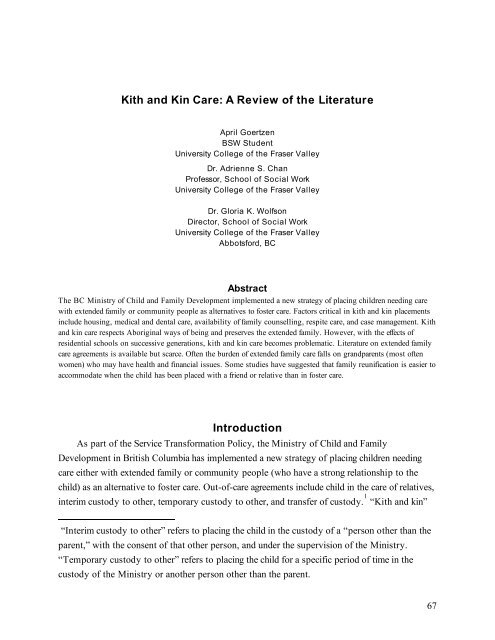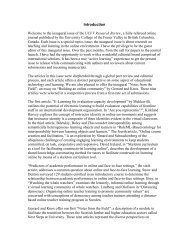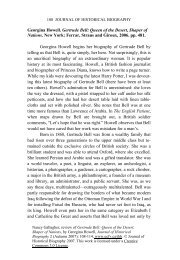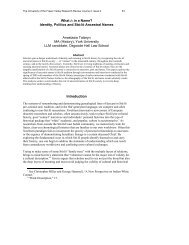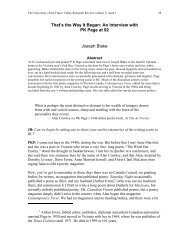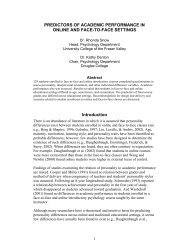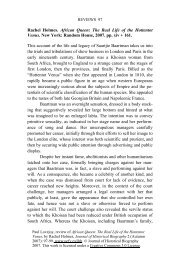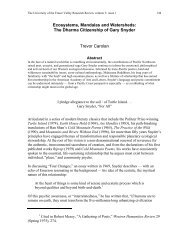Kith and Kin Care - Open Journal Systems
Kith and Kin Care - Open Journal Systems
Kith and Kin Care - Open Journal Systems
You also want an ePaper? Increase the reach of your titles
YUMPU automatically turns print PDFs into web optimized ePapers that Google loves.
<strong>Kith</strong> <strong>and</strong> <strong>Kin</strong> <strong>Care</strong>: A Review of the LiteratureApril GoertzenBSW StudentUniversity College of the Fraser ValleyDr. Adrienne S. ChanProfessor, School of Social WorkUniversity College of the Fraser ValleyDr. Gloria K. WolfsonDirector, School of Social WorkUniversity College of the Fraser ValleyAbbotsford, BCAbstractThe BC Ministry of Child <strong>and</strong> Family Development implemented a new strategy of placing children needing carewith extended family or community people as alternatives to foster care. Factors critical in kith <strong>and</strong> kin placementsinclude housing, medical <strong>and</strong> dental care, availability of family counselling, respite care, <strong>and</strong> case management. <strong>Kith</strong><strong>and</strong> kin care respects Aboriginal ways of being <strong>and</strong> preserves the extended family. However, with the effects ofresidential schools on successive generations, kith <strong>and</strong> kin care becomes problematic. Literature on extended familycare agreements is available but scarce. Often the burden of extended family care falls on gr<strong>and</strong>parents (most oftenwomen) who may have health <strong>and</strong> financial issues. Some studies have suggested that family reunification is easier toaccommodate when the child has been placed with a friend or relative than in foster care.IntroductionAs part of the Service Transformation Policy, the Ministry of Child <strong>and</strong> FamilyDevelopment in British Columbia has implemented a new strategy of placing children needingcare either with extended family or community people (who have a strong relationship to thechild) as an alternative to foster care. Out-of-care agreements include child in the care of relatives,interim custody to other, temporary custody to other, <strong>and</strong> transfer of custody. 1 “<strong>Kith</strong> <strong>and</strong> kin”“Interim custody to other” refers to placing the child in the custody of a “person other than theparent,” with the consent of that other person, <strong>and</strong> under the supervision of the Ministry.“Temporary custody to other” refers to placing the child for a specific period of time in thecustody of the Ministry or another person other than the parent.67
or “kinship care” are terms used to describe care where the child is in the home of a relative orsomeone close to the family. This includes people related to the child by blood, marriage, or whohave a family-like relationship.Current practice of out-of-care agreements is in evolution, while the use of kinship care is apractice that spans over 20 years. In British Columbia, kinship care relationships are currentlydefined as “. . .families providing full-time nurturing <strong>and</strong> protection of children with whom theyhave a kinship bond” (Ministry of Child <strong>and</strong> Family Development, 2003, p. 18). At present, outof-care<strong>and</strong> informal care includes those arrangements which result from court orders in BritishColumbia (2003). These arrangements mark a departure from most other child welfare agencies,where court-ordered placements are classified as formal kinship care.<strong>Kin</strong>ship care agreements are commonly defined as the placement of children with relatives(Dubowitz, Feigelman, & Zuravin, 1993). In the situations where there is no transfer of custodyto the caregiver who is a relative, this is known as informal kinship care (Dubowitz et al., 1993;Gordon, Mc<strong>Kin</strong>ley, Satterfield, & Curtis, 2003). This paper reviews the literature, considerskinship foster care as an alternative to taking a child into formal care, <strong>and</strong> identifies gaps in theliterature that warrant further research. The review will explore the context of current policy <strong>and</strong>practice related to kinship care, including international trends, theoretical perspectives, <strong>and</strong>ideological underpinnings. In addition, findings from a number of outcome studies that comparekinship care agreements to traditional foster care will be presented. Finally, this review willpresent information regarding the demographic profile of kinship caregivers, as well as what isknown about kinship care from the experiences <strong>and</strong> perspectives of caregivers themselves.International TrendsIn a number of countries (e.g., USA, Engl<strong>and</strong>, Irel<strong>and</strong>, Norway), kinship care is the fastestgrowing form of child placement in contemporary social work (Bonecutter & Gleeson inLorkovich, Piccola, Groza, Brindo, & Marks, 2004; Spence, 2004). Although informalplacements are not new, the shift by child welfare agencies favouring kinship placement optionsis a relatively new phenomenon, emerging in the 1980s (Geen & Berrick, 2002). Much of the“Transfer of custody to other” refers to cases where an application may be made to permanentlytransfer the custody of a child with a “continuing custody order” to a person other than theparent.68
available literature comes from the United States, where kinship care agreements account for anincreasing percentage of all out-of-home placements (Cuddeback, 2004; Ehrle & Geen, 2002;Harden, Clyman, Kriebel, & Lyons, 2004; Holtan, Ronning, H<strong>and</strong>egard, & Sour<strong>and</strong>er, 2005;Strozier, Elrod, Beiler, Smith, & Carter, 2004). According to the US Department of Health <strong>and</strong>Human Services (2000 as cited in Peters, 2005), an estimated 29% of all children in care areplaced with kin. This represents a significant increase from the 18% estimated in 1981(Kusserow, 1992 as cited in Geen & Berrick, 2002). This increase may be attributed to thegrowing emphasis on informal placements <strong>and</strong> keeping children out of mainstream foster care <strong>and</strong>residential care. While acknowledging an increased reliance on kin child welfare agencies over thepast two decades, Geen <strong>and</strong> Berrick (2002) report that use of kinship care has recently “leveledoff” (p. 1).Another significant portion of the literature related to kinship care originates from Great Britain.In a comprehensive review of primarily English contributions, Flynn (2002) documents anincreased use of kinship care agreements over the past 20 years. According to the Department ofHealth (2001 as cited in Flynn, 2002), children cared for by kin comprised approximately 16% ofthe total number of children in foster care in the year 2000. While most of the available literatureon kinship pertains to the USA <strong>and</strong> Great Britain, literature also exists which shows similartrends in Irel<strong>and</strong> (O’Brien, 2000 as cited in Flynn, 2002) <strong>and</strong> Norway (Holtan et al., 2005). Whilethe available literature clearly shows an international trend toward increased use of kinship careagreements for child welfare placements, actual research on kinship care is limited <strong>and</strong> “still in itsinfancy” (Holtan et al., 2005, p. 201).Theoretical PerspectivesVarious theoretical perspectives are used to underst<strong>and</strong> <strong>and</strong> support the use of kinship carearrangements. Gordon et al. (2003) observe a lack of clear consensus within the literatureregarding a conceptual framework for kinship care. Flynn (2002) also points out that a poorlydefined philosophy <strong>and</strong> inconsistent policies are characteristic in discussions of kinship care.Nevertheless, the most commonly cited perspective within the literature is family preservation(Dubowitz et al., 1993; Flynn, 2002; Gordon, et al., 2003; Lorkovich et al., 2004). Familypreservation is a model that emphasizes supporting <strong>and</strong> providing services to the family. In someinstances, family preservation is a service that is viewed as a preventative measure to takingchildren into care.69
Similarly, a growing underst<strong>and</strong>ing of the importance of cultural preservation also plays a keyrole in forming the framework for kinship care (Flynn, 2002; Iglehart, 2004; Ingram, 1996 as citedin Strozier et al., 2004). According to Hegar (as cited in Cuddeback, 2004), the primary advantageof kinship care is continuity of life within the child’s ethnic <strong>and</strong> religious community of origin.The conception of continuity of life forms the basis of a theoretical foundation.Ideological UnderpinningsIdeological views are an impetus for government policy in relation to child protection. This is animportant context for underst<strong>and</strong>ing kinship care <strong>and</strong> the emphasis being placed on kinship care.According to Ainsworth <strong>and</strong> Maluccio (1998), the trend toward greater use of kinship care mayindicate that agencies are becoming more sensitive to family, racial, ethnic, <strong>and</strong> cultural factors<strong>and</strong> the importance of family continuity in child development. While theoretically altruistic,kinship foster care might also be seen as reflecting a neo-conservative ideological stance in that itemphasizes “familial responsibility” <strong>and</strong> generally assumes less government involvement,particularly in terms of financial support (Geen & Berrick, 2002, p. 4).Gleeson (1996) places the policy debate regarding kinship care within the broader context ofUSA welfare reform, in which “cost-cutting is the primary concern” (p. 444). Because kinshipcaregivers typically receive less support <strong>and</strong> services than traditional foster caregivers (Chipman,Wells, & Johnson, 2002; Flynn, 2002), increased emphasis on kinship care placements must beexamined to determine whether the primary motivation really is concern for the best interests ofthe child, <strong>and</strong> not merely a matter of economics (Gleeson, 1996).Outcome StudiesOverall, less is known about the experiences of children than about other facets of kinship care.This is largely due to the fact that children represent the most vulnerable units of analysis in theresearch. While demographic information can be obtained through file review <strong>and</strong> otherunobtrusive methods, there is underst<strong>and</strong>ably very limited information available on theperceptions <strong>and</strong> experiences of children in kinship care. The most reliable information seems tobe found in outcome studies, <strong>and</strong> these are also few in number. As well, it would be relevant to beable to ascertain the long-term consequences of kinship as opposed to foster care. However, thiswould require longitudinal studies, which have not been done to date.70
A significant portion of the literature presents findings which show kinship care agreementsproduce more favourable outcomes compared to traditional foster care. In his comprehensivereview of the literature, Flynn (2002) concluded research to date showed children in kinship careagreements generally enjoyed greater stability <strong>and</strong> permanence, experienced fewer behaviourproblems, <strong>and</strong> did better in “virtually all respects” (p. 315).A recent study conducted by Holtan et al. (2005) supported previous findings regarding thesuperiority of kinship care. Their study of 214 children in kinship <strong>and</strong> nonkinship foster careshowed children in kinship foster care experienced fewer mental health problems, enjoyed greaterplacement stability, <strong>and</strong> had the added benefit of more frequent contact with their biologicalparents. Chapman, Wall, <strong>and</strong> Barth (2004) assert that children in kinship care appear to be“somewhat more content” than children in other types of placements (p. 302).Conversely, the literature also includes several studies which question the superiority of kinshipcare over traditional foster care. For example, one study by Cuddeback <strong>and</strong> Orme (2002) revealedfew differences between kinship <strong>and</strong> nonkinship care in terms of children’s problems. Benedict,Zuravin, <strong>and</strong> Stallings (1996) found that, contrary to their hypothesis, they could find nopatterns between traditional foster care <strong>and</strong> kinship-raised adults in terms of how well each groupwas faring in young adulthood. In addition, a cross-sectional study by Carpenter <strong>and</strong> Clyman(2004) found that women who lived in kinship care were more likely to experience pooremotional well-being compared to women who lived with at least one biological or adoptiveparent. Finally, the literature also reveals a number of disadvantages associated with kinship care,including lower incomes, higher stress, <strong>and</strong> slower rates of reunification <strong>and</strong> adoption (Chipmanet al., 2002; Cuddeback, 2004; Flynn, 2002; Geen & Berrick, 2002).Demographic CharacteristicsAmerican researchers observe that kinship caregivers tend to be older than traditional fosterparents (Cuddeback & Orme, 2002; Harden, Clyman, Kriebal, & Lyons, 2004). In examining thefindings of a study of 524 (state-involved) formal kinship placements, Dubowitz et al. (1993)noted that fewer than half of all the caregivers had completed high school <strong>and</strong> more than half wereunemployed. Interestingly, they found that despite these personal limitations, caregiversexpressed a high degree of willingness to care for their dependent kin. This finding is furthersupported by Spence (2004) who described an inherent sense of duty <strong>and</strong> responsibility thatrelatives feel to “care for their own”; it is also echoed by Beeman <strong>and</strong> Boisen (1999) who found71
that 83.4% of interviewed social workers thought relative caregivers were motivated by a desireto preserve family unity.In their examination of caregivers, Strozier et al. (2004) note the tendency of caregivers to be “. ..older, female single parents, who frequently have less education <strong>and</strong> are in poorer health thannon-kinship caregivers” (p. 642). This helps to explain the fact that kinship caregivers presentwith greater financial needs than do traditional foster parents, while kinship caregivers receivedless remuneration from the agency.In relation to the child’s education, Strozier et al. (2004) postulate that low education levels mayfacilitate caregivers’ feelings of inadequacy around helping their dependent kin with homework<strong>and</strong> with caregivers’ involvement in the child’s school. This finding is particularly interesting inlight of an observation that kinship caregivers are more likely to seek tutoring that enables themto assist with homework (Fox et al., 2000 as cited in Chipman et al., 2002).As of 1997, the vast majority of kinship care arrangements in the United States were informal(Strozier et al., 2004), <strong>and</strong> the majority of these caregivers were maternal gr<strong>and</strong>mothers(Cuddeback, 2004; Lorkovich et al., 2004). Several researchers also note that compared totraditional foster parents, kinship caregivers are more likely to be older, the heads of single-parenthouseholds, less educated, <strong>and</strong> in poor health (Chipman et al., 2002; Cuddeback, 2004;Scannapieco & Hegar, 2002). In his USA-based article, Cuddeback (2004) notes that caregiversare more likely to be African-American (citing Berrick, 1994; Gebel, 1996; Soloman & Marx,1995). However, it should be noted that African- American children are overrepresented in theAmerican foster care system. Cuddeback also describes caregivers as experiencing higher levels ofdepression, lower levels of marital satisfaction, <strong>and</strong> poorer health in general than traditional fosterparents. For instance, one study (Gaudin & Sutphen 1993) found that kinship caregivers are lesslikely to provide a safe <strong>and</strong> stimulating home environment (as cited in Cuddeback & Orme, 2002).From this, the question of causality arises: what is the relationship between the higher levels ofdepression <strong>and</strong> more limited access to financial resources?Shorkey <strong>and</strong> Mitchell (2003) report on a Canadian study of gr<strong>and</strong>parent kinship arrangements inOntario. They found that gr<strong>and</strong>parents take children into their homes to avoid placing the child inthe child welfare system. However, these kinship care arrangements create issues for thecaregivers including lack of financial support, lack of support <strong>and</strong> sense of isolation, stress <strong>and</strong>feelings of being overwhelmed, <strong>and</strong> change in life style <strong>and</strong> structure. The relationship betweenthe caregiver gr<strong>and</strong>parents <strong>and</strong> the child welfare system was perceived as ambivalent by the72
gr<strong>and</strong>parents. Shorkey <strong>and</strong> Mitchell suggest that these issues were, in part, due to lack of ongoingcontact, systems supports, <strong>and</strong> long-term planning.<strong>Care</strong>givers appear to encourage visitation with birth parents more than traditional foster parents,when taking into consideration visit <strong>and</strong> promotion of family ties. For example, this occursthrough visitation with the dependent kin’s biological parents <strong>and</strong>/or siblings. This may suggestthat kin families appreciate the importance of maintaining family connections, <strong>and</strong> prompts thequestion of whether this occurrence may (at least in part) be attributed to the greater sense ofduty <strong>and</strong> responsibility articulated by Spence (2004). Alternatively, it is possible that thecaregiver’s encouragement to visit biological parents <strong>and</strong> siblings suggests that competingloyalties may exist between the dependent kin <strong>and</strong> the kin’s parent, who is often the caregiver’soffspring or sibling.Information regarding the demographic profile of kinship caregivers in Great Britain is quitelimited; however, several studies indicate a majority of kinship caregivers are maternalgr<strong>and</strong>parents (gender not specified) <strong>and</strong> maternal aunts (Flynn, 2002). An exception to thispattern was seen to exist among families from South Asian <strong>and</strong> Chinese communities, where morethan half of kinship caregivers were paternal gr<strong>and</strong>parents (Richards, 2001 as cited in Flynn,2002). These patterns would be characteristic of current cultural practices in terms of definingfamilial responsibility for children. Waterhouse (2001 as cited in Flynn, 2002) found equalrepresentation of both maternal <strong>and</strong> paternal relatives among kinship caregivers, includinggr<strong>and</strong>parents, aunts, <strong>and</strong> uncles.Demographics of ChildrenIn their comprehensive review of children in kinship care, Dubowitz et al. (1993) observed thatchildren placed into kinship care were usually placed at a younger age than those placed intraditional foster care. They also noted that the duration of the placement was usually longer thantraditional foster care. This second discovery is significant when considered in concert with thefinding (mentioned in the previous section) that relative caregivers are more likely to encouragevisitation with the biological parent(s). It appears plausible that the caregiver’s belief in the valueof visitation is not linked to the caregiver’s belief in family reunification.Spence (2004), in his review of kinship care in Australia, concludes that the most common reasonfor kinship placement is risk of harm or neglect to the child <strong>and</strong> that kinship care is the mostlikely placement option for children in all age groups, except children who are 16–17 years of age.73
Spence also found that children did not appear to participate extensively in decision-makingprocesses around care or parenting issues. If the children most likely to be placed in kinship careare young, then it follows that they would not be as involved in decision making. This findingappears to be consistent with the American study conducted by Dubowitz et al. (1993)previously mentioned.Chipman et al. (2002) discuss types of living arrangements for children in kinship arrangements.They recognized an important distinction between kinship children <strong>and</strong> those in traditional fostercare. <strong>Kin</strong>ship children tend to live in neighbourhoods that are considered to be more dangerous,<strong>and</strong> they are less likely to live in single-family (i.e., detached) housing. Additionally, kinshipchildren are exposed to higher levels of violence (Fox et al., 2000 as cited in Chipman et al.,2002). This is consistent with the previously stated findings that families providing kinship caretend to be less financially well off than the more ‘professionalized’ <strong>and</strong> financially supportedfoster families. Fortunately, these statistics do not appear to reflect a lower level of concern forthe children. Rather, high levels of support <strong>and</strong> concern for overall well-being <strong>and</strong> futureexpectations were noted for both groups.Level of Special Needs ChildrenCuddeback <strong>and</strong> Orme (2002) identified the needs of kinship children as being at least as great asthose faced by traditional foster children (cf., Benedict et al., 1996; Berrick et al., 1994 as cited inCuddeback, 2004; Dubowitz et al., 1993; Iglehart, 2004), including problems in school, healthcare, <strong>and</strong> mental health referrals <strong>and</strong> services. Overall, the findings on children with special needsappear mixed. Iglehart found few differences between the two groups, with the exception ofmental health needs. In the area of mental health, kinship children are less likely to be referred formental health services, <strong>and</strong> they are more likely to have a serious mental health problem (Cantos,Gries, & Slis, 1996; Cuddeback & Orme, 2002). This may be due to the associated stigma <strong>and</strong>trauma that a family experiences when they find that their child, or the child they are caring for,has possible mental health issues.<strong>Care</strong>giver PerspectivesGordon et al. (2003) found that many caregivers “. . .assumed responsibility for the children”prior to the children arriving in their home (p. 86). Gr<strong>and</strong>parents often worried about the children74
<strong>and</strong> desired to provide a safe place for the children (Gordon et al., 2003). These findings supportthe belief that family members do experience a sense of duty <strong>and</strong> obligation that may not bepresent to the same degree in traditional foster homes.One study by Chipman et al. (2002) found caregivers’ primary motivation in their kinship careagreements centred around their ability to meet the child’s developmental needs, <strong>and</strong> to providechildren with love <strong>and</strong> moral or spiritual guidance. Some specific challenges encountered bycaregivers were also identified in this study, including difficulties related to their “emotionalattachment” with the child’s birth parent <strong>and</strong> inadequate resources <strong>and</strong> support (p. 519).A significant number of studies indicate that kinship caregivers are not compensated adequatelyfinancially (Chipman et al., 2002; Connolly, 2003; Department of Health, 2002; Hunt, 2003;Szolnoki & Cahn, 2002). Families often have differing perceptions <strong>and</strong> feelings about caring <strong>and</strong>supporting children for financial compensation, especially when there is a close relationship withthe biological parents (O’Brien, 2000). At the same time kinship caregivers may question whyfoster parents, who are strangers, receive greater compensation than family caregivers.Data regarding parenting styles <strong>and</strong> experience is mixed. Harden et al. (2004) ascribe this lack ofconsistency in the data to limited methodological rigor. While some studies found that kinshipparents appear less empathic (Gebel, 1996 as cited in Harden et al., 2004), other studies havefound no significant differences in the level of supportiveness <strong>and</strong> attention to particular needsbetween traditional foster parents <strong>and</strong> relative caregivers (Berrick, 1997 as cited in Harden et al.2004). These observations prompt the question as to what causes the apparent demonstration ofless empathy. In previous research, it has been suggested that caregivers are more likely toexperience depression (Cuddeback, 2004). <strong>Care</strong>givers describe adverse effects that the kinshipplacement has had on their other significant relationships with spouses, children, <strong>and</strong> othergr<strong>and</strong>children (Chipman et al., 2002). It is possible that low empathy reflects struggles related tothe relationship, rather than to a particular dynamic between the caregiver <strong>and</strong> kin.Social Worker PerspectivesSocial workers generally agree that the child welfare agency should not hold kinship caregivers tothe same rigorous st<strong>and</strong>ards as foster parents in criteria such as housing <strong>and</strong> training requirements(Chipman et al., 2002). This suggestion is echoed by Cuddeback (2004), who affirms the ChildWelfare League’s recommendation that the same st<strong>and</strong>ards should apply to kinship <strong>and</strong>nonkinship caregivers as it relates to safety <strong>and</strong> protection but that greater flexibility ought to be75
applied when safety is not an issue. This means that once safety is no longer an issue, caregiverscan be given more freedom <strong>and</strong> flexibility for broad concerns such as accommodation <strong>and</strong>experience. This perspective appears to support current practice, where most kinship caregiversare unlicensed <strong>and</strong> are entering into care agreements out of a sense of family responsibility <strong>and</strong>preservation (Beeman & Boisen, 1999).Workers note that although “some screening occurs prior to placement. . .subsequentassessments sometimes reveal significant issues that if known in advance, would have precludedthe placement decision” (Chipman et al., 2002, p. 512). Some social workers in thiscomprehensive study expressed concern that the agency could not guarantee the child’s safety<strong>and</strong> protection in kinship settings, due to the competing loyalties between the biological parent<strong>and</strong> the dependent kin. The researchers note that this risk is especially great if the caregiver doesnot believe that the allegations against the biological parent are true. Conversely, Beeman <strong>and</strong>Boisen (1999) found that, although neutral about the concept of kinship foster care in general, themajority of social workers believe that kinship caregivers are competent foster parents <strong>and</strong> thatchildren are better off in a kin environment as kinship children are believed to have a strongersense of identity <strong>and</strong> be less troubled.In terms of financial compensation, workers who participated in the Chipman et al. (2002) studysuggested that relative caregivers should be entitled to the same amount of remuneration astraditional foster parents, even though the workers generally did not want caregivers to gothrough the licensing process (i.e., in the USA). A small number of case workers suggested thatkinship caregivers should not receive comparable funding to foster parents because of theexpectation of family care that could ‘naturally’ extend to kinship care. This view has beenechoed in other studies (Geen, 2003). Chipman et al. (2002) provided complex <strong>and</strong> detailedinformation from a diverse group of participants, including caregivers <strong>and</strong> caseworkers.Comparison of Goals <strong>and</strong> ObjectivesA noteworthy observation made by Chipman et al. (2002) is that the primary objective of theagency is different than that of the caregiver. The agency’s m<strong>and</strong>ate is the safety <strong>and</strong> protectionof the child, manifested as ‘permanency’ status for the child. In contrast, the caregiver often haslove <strong>and</strong> moral/spiritual guidance as their goal, which frequently manifests itself as appropriatebehaviour, school performance <strong>and</strong> happiness for the child. The emphasis on love <strong>and</strong> happinessmay contribute to the pervasive difficulties present in the ongoing relationship between76
caregivers <strong>and</strong> biological parents, as identified by workers; although the caregivers valuehappiness <strong>and</strong> family unity, there is often a great deal of tension between the biological parent<strong>and</strong> the caregiver <strong>and</strong> kin (Beeman & Boisen, 1999).ImplicationsChipman et al. (2002) discuss the position of some workers who stress the need to avoidunplanned placements wherever possible <strong>and</strong> who recognize the importance in m<strong>and</strong>atory preplacementassessments. Further, Chipman et al. (2002) suggest the need to correct the unevenprovision of resources <strong>and</strong> support to different types of foster caregivers, including financial <strong>and</strong>monitoring services. Inherent in this is the implication that the role of the child welfare agency inkinship agreements should be reviewed. As well, many caregivers identified a need for morefrequent <strong>and</strong> relevant contact with agency staff. This need for contact is especially important inlight of the limited training <strong>and</strong> preparation that most relative caregivers receive (Beeman &Boisen, 1999; Cuddeback & Orme, 2002). Scannapieco <strong>and</strong> Hegar (2002) affirm the need forfinancial <strong>and</strong> emotional support to caregivers <strong>and</strong> kin; they also emphasize the need for a“multidimensional assessment” (p. 325) to address the needs that may exist for care providers.Beeman <strong>and</strong> Boisen (1999) encourage agencies to recognize the uniqueness of kinship agreements<strong>and</strong> of the role of relative caregiver. They further urge workers to clearly relay the expectations<strong>and</strong> objectives that exist from the agency’s perspective, since there is often a disparity betweencaregiver <strong>and</strong> agency objectives. They also advocate for “cultural competence” (p. 334) amongworkers, to be achieved through ongoing training. This recommendation is based on the datawhich reveal higher proportions of kinship relationships are comprised of people of colour, <strong>and</strong>data reveal that white workers in their study were more likely to believe that kinship caregiverswere more difficult to supervise than traditional foster parents (Beeman & Boisen, 1999).Cuddeback (2004) concludes that kinship-placed children experience lower levels of trauma <strong>and</strong>stigma than children placed in traditional foster care. His greatest recommendation, however,concerns future research. Cuddeback argues that extensive rigorous research is needed to betterunderst<strong>and</strong> <strong>and</strong> prescribe effective interventions. Specifically, he advocates for methodologicalimprovements, including longitudinal designs <strong>and</strong> st<strong>and</strong>ardized measurements.Conclusion77
While there has been substantial research done on American, Australian, <strong>and</strong> British kinshipplacements, there is a deficit in the literature <strong>and</strong> research reflecting Canadian placements. Forexample, it is documented that in the United States, the vast majority of kinship placementscontinue to be informal, where there is no transfer of custody to the relative caregiver (Strozier,Elrod, Beiler, Smith, & Carter, 2004). The literature also reveals that in many other countries,kinship placements represent the fastest growing form of care (Bonecutter & Gleeson, 1997) ascited in Lorkovich et al., 2004; Spence, 2004).This review has presented what is known from the current body of literature about kinship carein terms of the international, theoretical, <strong>and</strong> ideological context, as well as what has been learnedfrom various outcome studies <strong>and</strong> information provided by social workers <strong>and</strong> kinship caregivers.British Columbia is currently utilizing <strong>and</strong> promoting kinship care agreements as an integral partof its child protection strategy, <strong>and</strong> it is therefore imperative that Canadian research be conductedin order to better support <strong>and</strong> guide policy <strong>and</strong> practice. This literature review reveals a need forboth quantitative <strong>and</strong> qualitative data in relation to kinship care.ReferencesAinsworth, F., & Maluccio, A. N. (1998). <strong>Kin</strong>ship care: False dawn or new hope? AustralianSocial Work, 51(4), 3–8.Beeman, S., & Boisen, L. (1999). Child welfare professionals’ attitudes toward kinship fostercare. Child Welfare, 78, 315–337.Benedict, M. I., Zurabin, S., & Stallings, R. Y. (1996). Adult functioning of children who lived inkin versus nonrelative foster homes. Child Welfare, 75, 529–549.Carpenter, S. C., & Clyman, R. B. (2004). The long-term emotional <strong>and</strong> physical well-being ofwomen who have lived in kinship care. Children <strong>and</strong> Youth Services, 26, 673–686.Chapman, M. V., Wall, A., & Barth, R. P. (2004). Children’s voices: The perceptions of childrenin foster care. American <strong>Journal</strong> of Orthopsychiatry, 74(3), 293–304.Chipman, R., Wells, S. J., & Johnson, M. A. (2002). The meaning of quality in kinship fostercare: <strong>Care</strong>giver, child <strong>and</strong> worker perspectives. Families in Society: The <strong>Journal</strong> ofContemporary Human Services, 83(5/6), 508–520. Retrieved September 21, 2005, fromAcademic Search Premier.Connolly, M. (2003). <strong>Kin</strong>ship care: A selected literature review. Wellington, New Zeal<strong>and</strong>:78
Department of Child, Youth <strong>and</strong> Family. Retrieved September 10, 2005, fromhttp://www.cyf.govt.nz/documents/<strong>Kin</strong>ship<strong>Care</strong>.pdfCuddeback, G. S. (2004). <strong>Kin</strong>ship family foster care: A methodological <strong>and</strong> substantive synthesisof research. Child <strong>and</strong> Youth Services Review, 26(7), 623–639. Retrieved September 19,2005, from http://www.sciencedirect.com/science/journal/01907409Cuddeback, G. S., & Orme, J. G. (2002). Training <strong>and</strong> services for kinship <strong>and</strong> nonkinship fosterfamilies. Child Welfare, 81(6), 879–910.Department of Health. (2002). Friends <strong>and</strong> family care (<strong>Kin</strong>ship care): Current policyframework, issues <strong>and</strong> options. Norwich, United <strong>Kin</strong>gdom. Retrieved April 10, 2006, fromhttp://www.dh.gov.uk/assetRoot/04/05/93/60/04059360.pdfDubowitz, H., Feigelman, S., & Zuravin, S. (1993). A profile of kinship care. Child Welfare,72(2), 153–169.Dubowitz, H., Zuravin, S., Starr, R., Feigelman, S., & Harrington, D. (1993). Behavior problemsof children in kinship care. Development <strong>and</strong> Behavioral Pediatrics, 14, 386–393.Ehrle, J., & Geen, R. (2002). <strong>Kin</strong> <strong>and</strong> non-kin foster care — Findings from national survey.Children <strong>and</strong> Youth Services Review, 24(1/2), 15–35.Flynn, R. (2002). Research review. Child <strong>and</strong> Family Social Work, 7, 311–321.Geen, R. (2003). <strong>Kin</strong>ship foster care, an ongoing, yet largely uninformed debate. In R. Geen(Ed.), <strong>Kin</strong>ship care: Making the most of a valuable resource. Washington, DC: The UrbanInstitute Press.Geen, R., & Berrick, J. D. (2002). <strong>Kin</strong>ship care: An evolving service delivery option. Child <strong>and</strong>Youth Services Review, 24(1/2), 1–14.Gleeson, J. P. (1996). <strong>Kin</strong>ship care as a child welfare service: The policy debate in an era ofwelfare reform. Child Welfare, 75(5), 419–449.Gordon, A. L., Mc<strong>Kin</strong>ley, S. E., Sattterfield, M. L., & Curtis, P. A. (2003). A first look atenhanced support services for kinship caregivers. Child Welfare, 82(1), 77–96.Harden, B. J., Clyman, R. B., Kriebel, D. K., & Lyons, M. E. (2004). <strong>Kith</strong> <strong>and</strong> kin care: Parentalattitudes <strong>and</strong> resources of foster <strong>and</strong> relative caregivers. Child <strong>and</strong> Youth Services Review,26(7), 657–671. Retrieved September 19, 2005, fromhttp://www.sciencedirect.com/science/journal/01907409Holtan, A., Ronning, J. A., H<strong>and</strong>egard, B. H., & Sour<strong>and</strong>er, A. (2005). A comparison of mentalhealth problems in kinship <strong>and</strong> nonkinship foster care. European Child & AdolescentPsychiatry, 14(4), 200–207.Hunt, J. (2003). Family <strong>and</strong> friends carers report. United <strong>Kin</strong>gdom: Department of Health.Retrieved September 19, 2005, from http://www.everychildmatters.gov.uk/fostercareIglehart, A. P. (2004). <strong>Kin</strong>ship foster care: Filling the gaps in theory, research, <strong>and</strong> practice. Child79
<strong>and</strong> Youth Services Review, 26(7), 613–621. Retrieved September 19, 2005, fromhttp://www.sciencedirect.com/science/journal/01907409Lorkovich, T. W., Piccola, T., Groza, V., Brindo, M. E., & Marks, J. (2004). <strong>Kin</strong>ship care <strong>and</strong>permanence: Guiding principles for policy <strong>and</strong> practice. Families in Society: The <strong>Journal</strong> ofContemporary Social Services, 85(2), 159–164.Ministry of Children <strong>and</strong> Family Development. (2003). Agreements with a child’s kin <strong>and</strong>others: Reference guide. Victoria, BC: Queen’s Printer.O’Brien, V. (2000). A different type of foster care- — Implications for practice. In G. Kelly &R. Gilligan (Eds.), Issues in Foster <strong>Care</strong>. London: Jessica <strong>Kin</strong>gsley.Peters, J. (2005). True ambivalence: Child welfare workers’ thoughts, feelings, <strong>and</strong> beliefs aboutkinship foster care. Children <strong>and</strong> Youth Services Review, 27(6), 595–614. Retrieved October1, 2005, from http://www.sciencedirect.com/science/journal/01907409Scannapieco, M., & Hegar, R. L. (2002). <strong>Kin</strong>ship care providers: Designing an array ofsupportive services. Child <strong>and</strong> Adolescent Social Work <strong>Journal</strong>, 19(4), 315–327.Shlonsky, A. R., & Berrick, J. D. (2001). Assessing <strong>and</strong> promoting quality in kin <strong>and</strong> nonkincare. Social Service Review, 75(1), 60–83.Shorkey, D., & Mitchell, B. (2003). Gr<strong>and</strong>parents raising their children. In K. Kufeldt & B.McKenzie (Eds.), Child welfare: Connecting research, policy, <strong>and</strong> practice (pp. 147–156).Waterloo, ON: Wilfred Laurier University PressSpence, N. (2004). <strong>Kin</strong>ship care in Australia. Child Abuse Review, 13(4), 263–276. RetrievedJune 27, 2005, from http://www3.interscience.wiley.comStrozier, A. L., Elrod, B., Beiler, P., Smith, A., & Carter, K. (2004). Developing a network ofsupport for relative caregivers. Child <strong>and</strong> Youth Services Review, 26(7), 641–656. RetrievedSeptember 19, 2005, from http://www.sciencedirect.com/science/journal/01907409Szolnoki, J., & Cahn, C. (2002). African American kinship caregivers: Principles for developingsupportive programs. Seattle, WA: Northwest Institute for Children <strong>and</strong> Families.University of Washington, School of Social Work. Retrieved September 20, 2005, fromhttp://depts.washington.edu/nwicf/Policy_Grant_Maker/kinshipcare.html80


